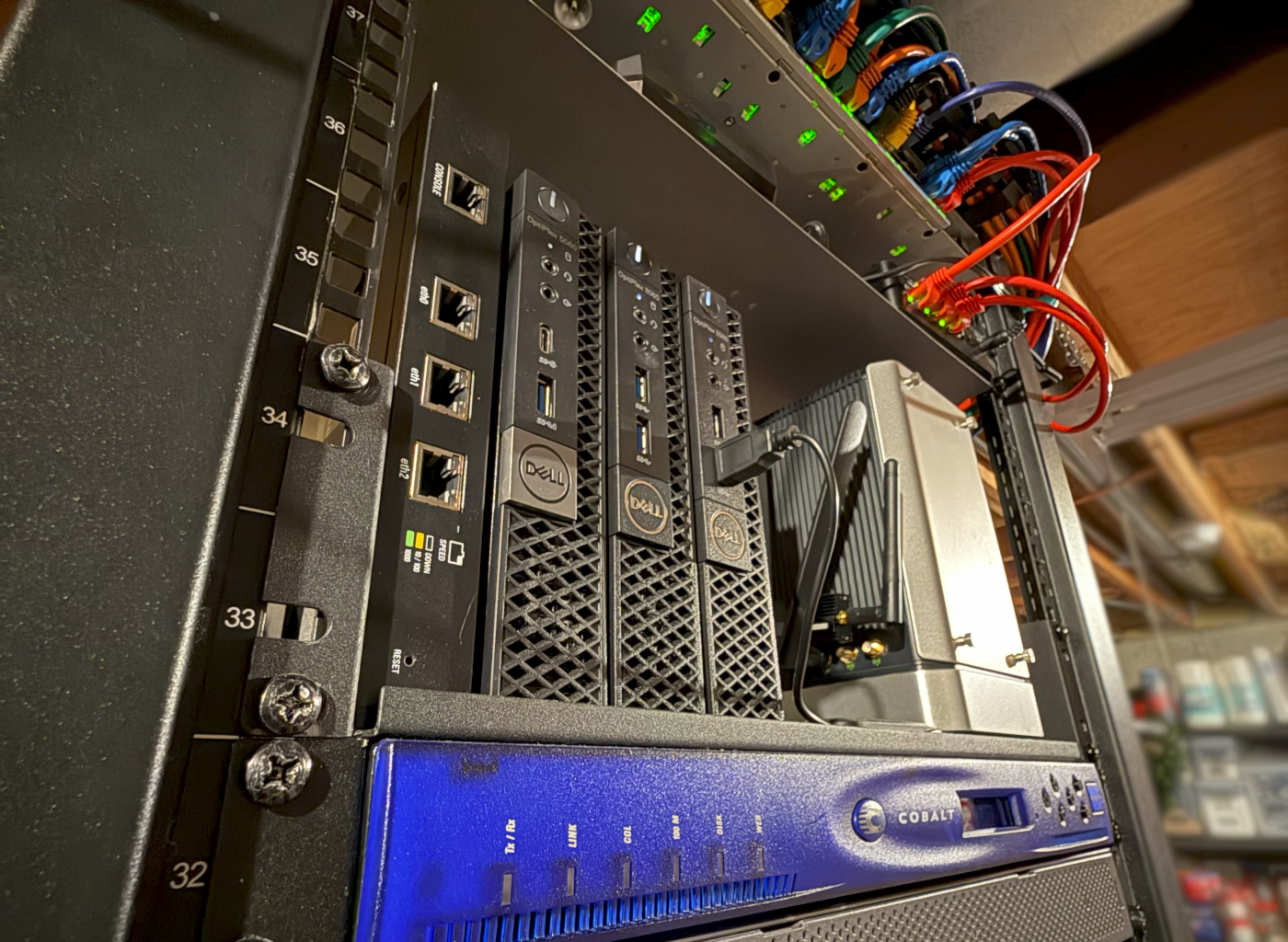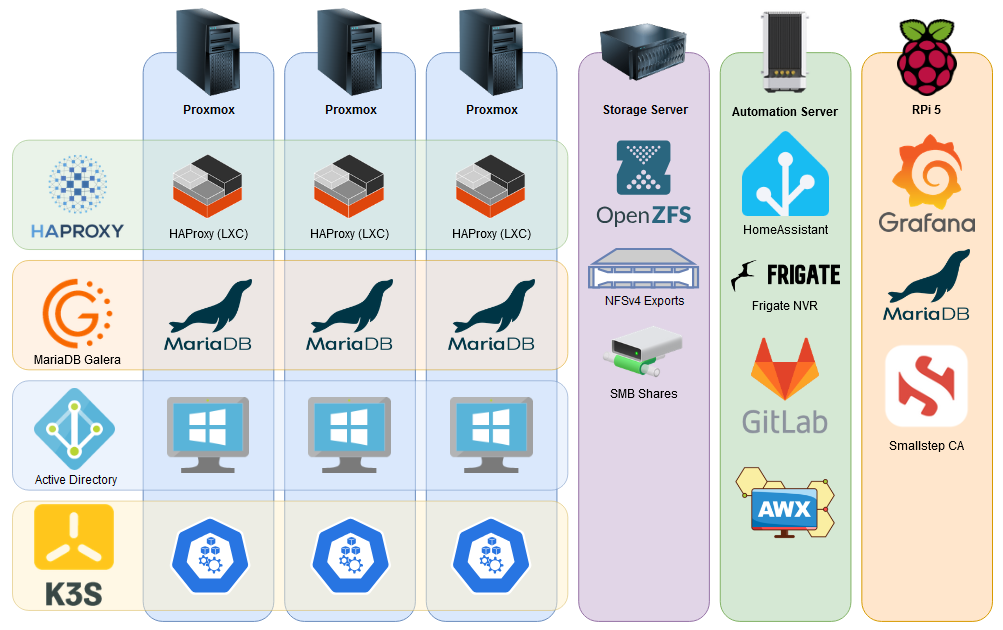What’s In My Lab Now, 2024 Edition

Almost four years ago (agh!) I published What’s In My Lab, an overview of the systems and software I use at home for my own personal infrastructure. You might think that at a certain point you achieve some kind of serenity, and the desire to modify or expand is sated. Hah! Guess again.
Hardware#
I’ve continued with the trend of using low-power off-the-shelf systems. The beauty of a product line like Dell’s OptiPlex Micro is that the design is essentially unchanging from one generation to the next. Where I used to have a range of models - 7040, 5050, etc. - I’ve slowly upgraded them all to the same generation of 3060s. One extra feature I’ve added that you won’t find on a stock OptiPlex Micro is a secondary NIC from DFRobot connected to the WiFi M.2 slot, giving each Micro an extra 1GbE port for redundancy or a dedicated storage network.
There are only so many hard drives you can cram into an OptiPlex Micro - one, to be exact, of the 2.5" variety - so my storage needs are still served by a 2U SuperMicro rackmount server sporting 12 3.5" SAS drives split across two ZFS pools.
Since my last post, I’ve also added a Home Automation server built on a SeeedStudio reServer, a vertical small form factor machine with space for two 3.5" SATA hard drives and an array of connectivity and expansion options tailored for edge computing applications. This server runs HomeAssistant, Z-Wave and Zigbee hubs, and the Frigate NVR software which uses Intel’s Rocket Lake integrated GPU to perform object detection and inferencing using the OpenVINO framework.
I also have two vintage systems from SGI and Sun which I occasionally power on and take for a spin.
| System | CPU | Memory |
|---|---|---|
| OptiPlex 3060 | Intel Core i5-8500T | 32GB DDR4 |
| OptiPlex 3060 | Intel Core i5-8500T | 32GB DDR4 |
| OptiPlex 5060 | Intel Core i5-8500T | 32GB DDR4 |
| SuperMicro CSE-826 | Dual Intel Xeon E5-2630v4 | 64GB DDR4 |
| reServer i31115 | Intel Core i3 1115G4 | 32GB DDR4 |
| Raspberry Pi 5 | ARM Cortex-A76 2.4GHz | 8GB LPDDR4X |
| Sun Netra X1 | 400MHz UltraSPARC IIe | 1GB PC133 |
| Cobalt “RaQFive” | StarFive JH7110 SoC 1.5GHz | 8GB DDR LPDDR4 |
| SGI O2 | MIPS R5000 180MHz | 1GB 133MHz SDRAM |
Hypervisors#
Proxmox VE continues to punch well above its weight class.

Services#
Not much has changed here, but some services have been retired and replaced with other products.
- HAProxy
- Three very lightweight LXD containers serving as a virtual network load balancer
- HAProxy acts as a TCP and HTTP load balancer
- Keepalived manages virtual IPs that failover between the two containers
- MariaDB Galera Cluster
- Three Debian LXD containers running MariaDB with Galera multi-master replication
- Clients access the MariaDB cluster using a VIP and server pool managed by the HAProxy cluster
- I wrote a monitoring daemon in Go that provides HTTP healthcheck capabilities for HAProxy to determine the health of each MariaDB instance
- Ceph
- Each Proxmox host runs a Ceph mon (monitor), mgr (manager), and mds (metadata service)
- Each host also runs a Ceph OSD on an internal 2.5" enterprise SATA SSD
- Active Directory
- Two Windows Server 2022 VMs across each host provide Active Directory Domain Services and DNS
- One Windows Server 2022 VM hosts an Active Directory Certificate Services intermediate CA for my private CA hierarchy
- Kubernetes
- 3 worker nodes running K3s, a lightweight edge-focused Kubernetes distribution
- The K3s cluster is highly-available, with the K8s API accessible through the HAProxy load balancer cluster
- Workloads on Kubernetes can leverage the external MariaDB and Ceph clusters for persistence
In addition to these clustered services, I also deployed a few services for better management and visibility across my environment:
- Ansible AWX
- Manages automation for VMs, LXD containers, and physical hosts
- I use a number of open-source roles from the Ansible Galaxy community, and even contribute bugfixes and improvements to a few as I’m able!
- Graylog Open
- I use a few different Graylog inputs to receive data from all of my endpoints:
- Syslog data from rsyslog
- GELF from Docker engines and Kubernetes pods
- Beats for Windows event logging with Winlogbeat
- Graylog’s Sidecar functionality made it significantly easier to manage my Winlogbeat collectors in a central place, rather than relying on deploying winlogbeat via GPO!
- I use a few different Graylog inputs to receive data from all of my endpoints:
- InfluxDB
- Aggregates time-series monitoring data from telegraf clients on Linux
- Grafana
- Observability into my entire infrastructure
- Presents metrics from InfluxDB in customized dashboards for each of my home lab services